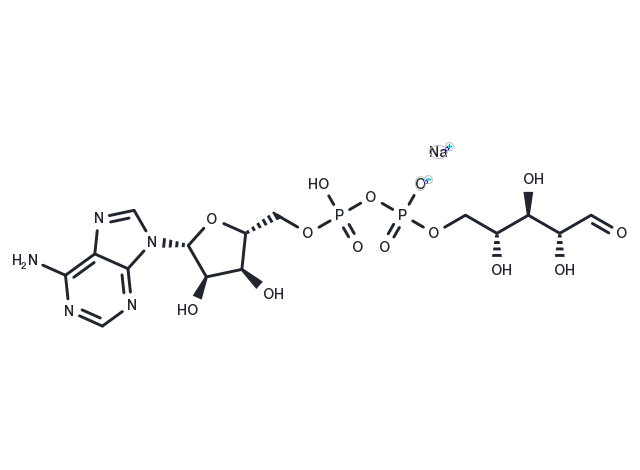Powder: -20°C for 3 years | In solvent: -80°C for 1 year


Adenosine 5'-diphosphoribose sodium (ADP ribose sodium) is a metabolite of nicotinamide adenine nucleotide (NAD+), which is widely present in organisms.Adenosine 5'-diphosphoribose sodium (ADP ribose sodium) is a potent intracellular Ca2+-permeable cation TRPM2 channel activator. Adenosine 5'-diphosphoribose sodium (ADP ribose sodium) is a potent intracellular Ca2+ permeable cation TRPM2 channel activator that also induces autophagy.)

| Pack Size | Availability | Price/USD | Quantity |
|---|---|---|---|
| 5 mg | In stock | $ 61.00 | |
| 10 mg | In stock | $ 97.00 | |
| 25 mg | In stock | Inquiry | |
| 50 mg | In stock | Inquiry |

| Description | Adenosine 5'-diphosphoribose sodium (ADP ribose sodium) is a metabolite of nicotinamide adenine nucleotide (NAD+), which is widely present in organisms.Adenosine 5'-diphosphoribose sodium (ADP ribose sodium) is a potent intracellular Ca2+-permeable cation TRPM2 channel activator. Adenosine 5'-diphosphoribose sodium (ADP ribose sodium) is a potent intracellular Ca2+ permeable cation TRPM2 channel activator that also induces autophagy.) |
| In vitro | In mouse embryonic fibroblasts (MEFs), H2O2 treatment demonstrates that the activation of PARP-1 produced Adenosine 5'-diphosphoribose (ADP ribose), which is an activating signal for TRPM2 channels, thereby promoting Ca2+ elevation through extracellular Ca2+ influx and (or) lysosomal Ca2+ release. This process eventually activates early or late autophagy in response to different degrees of oxidative stress.[1] |
| Synonyms | Adenosine 5'-diphosphoribose sodium, ADP ribose sodium |
| Molecular Weight | 581.3 |
| Formula | C15H22N5NaO14P2 |
| CAS No. | 68414-18-6 |
Powder: -20°C for 3 years | In solvent: -80°C for 1 year
DMSO: 20 mg/mL (34.41 mM), Sonication is recommended.
H2O: 100 mg/mL (172.03 mM), Sonication is recommended.
You can also refer to dose conversion for different animals. More
bottom
Please see Inhibitor Handling Instructions for more frequently ask questions. Topics include: how to prepare stock solutions, how to store products, and cautions on cell-based assays & animal experiments, etc.
Adenosine 5'-diphosphoribose sodium 68414-18-6 Autophagy Membrane transporter/Ion channel Metabolism TRP/TRPV Channel Endogenous Metabolite ADP ribose sodium inhibitor inhibit
